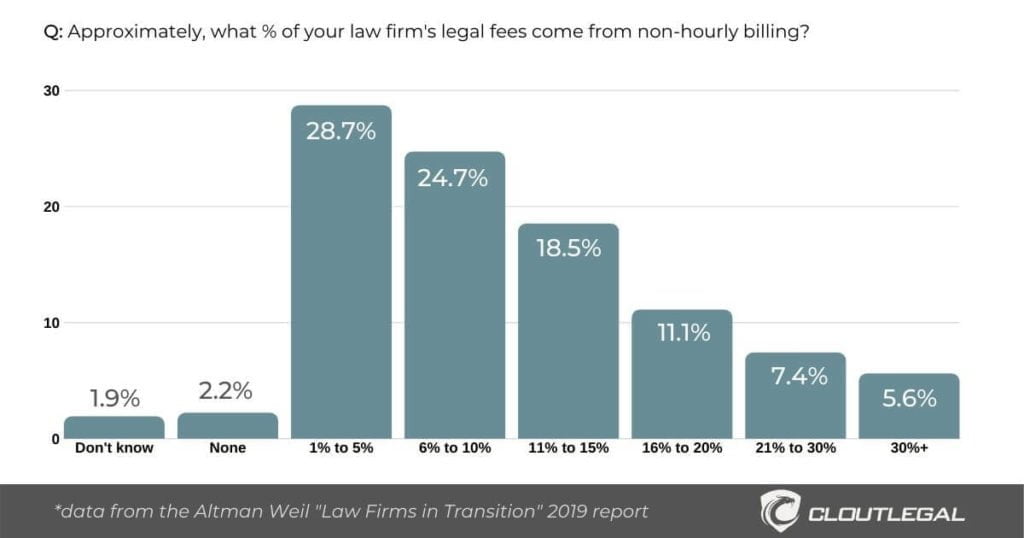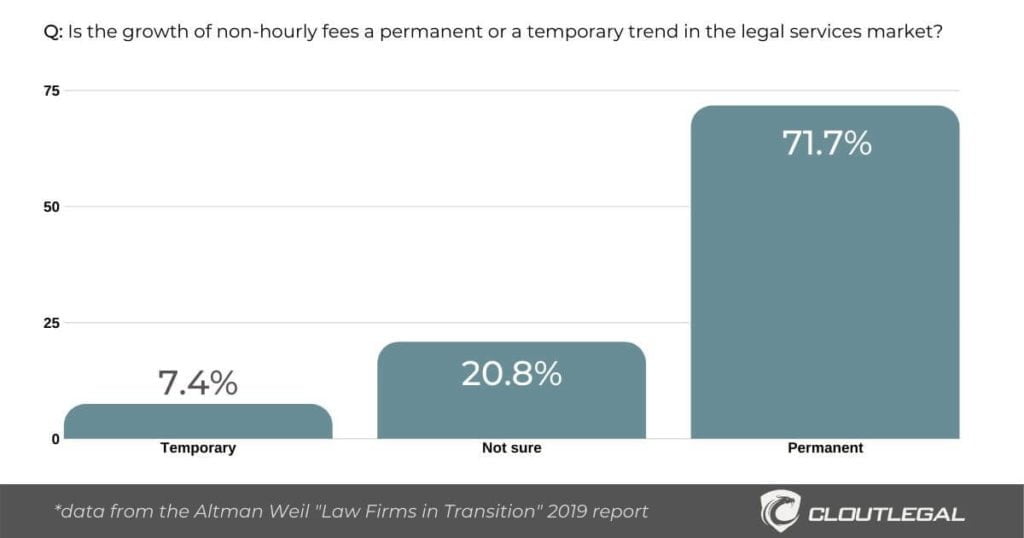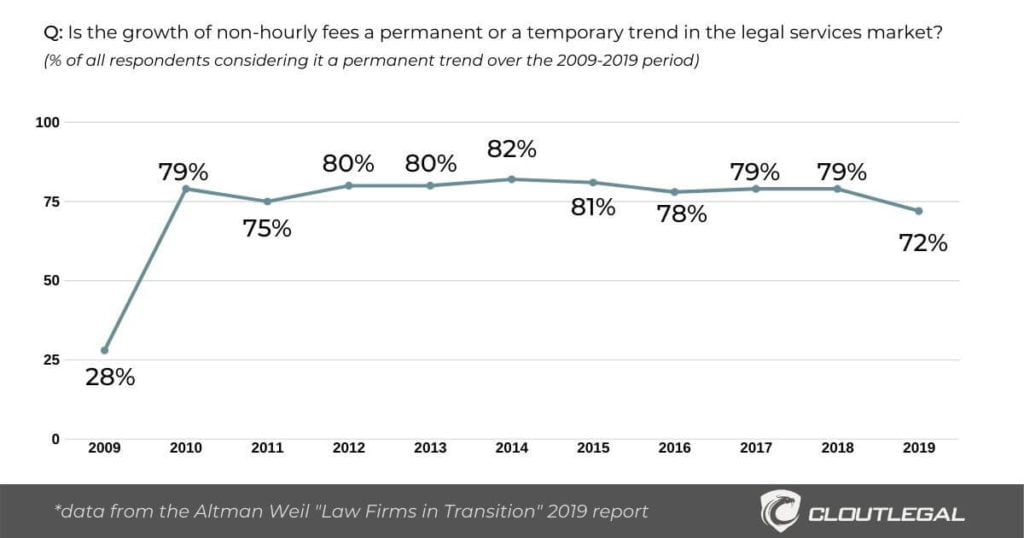The eternal debate on legal fees
"The Billable Hour is a classic case of restricted autonomy. You're focused on hitting your numbers, not on doing a good job. It's one reason why lawyers typically are so unhappy..." - Daniel H. Pink
The billable hour and alternative fee arrangements “pro and cons” debate has been raging for years decades. Yet, both categories of legal fees maintain their appeal to different stakeholders.
(I used to write about law firm billing models before, and still, I find fascinating how one (seemingly) simple topic (i.e. legal fees) can be so polarizing)
In this article, I am going to focus on the Billable Hour as a BigLaw legal billing model of choice.
If you ever wondered...
who invented the timesheet; how or when did the Billable Hour become popular; what is the current state of hourly billing vis a vis alternative legal fees;
how BigLaw uses the Billable Hour (for charging, measuring and forecasting); what are BigLaw billable requirements; how much you need to work to hit your 1800, 2000, 2200+ annual billable targets (and is it even humanly possible to bill 3500 hours annually);
what are ethical and compliance risks of the Billable Hour; is the Billable Hour slowing down legal innovation; how do you scale your billable hours, and what to do to actually create a scalable legal business;
why law firms still use the billable hour, and why would clients accept it nowadays; are there any law firms without billable hours; and how you can stop using the Billable Hour - if you choose to do so...
(phew, that was a long one…)
...then, by all means, dive right in. You will find my thoughts on the above questions (and then some). I try to condense years and years of research - not only mine - but also of renowned authors in the Business of Law and legal tech.
Photo by Vincent Chan on Unsplash
The Billable Hour ultimate guide for 21st-century lawyers
Think of this post as a sort of the ultimate guide to the Billable Hour - what it is, how it came to be, how it is used today, and - maybe most importantly - how to evolve beyond the clock right into a scalable legal services (and products) business.
If you are rather fresh to the debate and would like to delve in - just read on. For those of you that are more familiar, feel free to jump into those sections that interest you the most.
(also, for those of you that prefer the TL;DR version - the is the FAQ section at the bottom of this article with brief answers to said questions)
Let’s get right into it.
Table of contents
The Anatomy of the Billable Hour
“Time is what we want most, but what we use worst.” - William Penn
The earlier article that I wrote about time billing (aptly titled “The Anatomy of the Billable Hour) also referred to the lasting debate. The goal of the said article (much like here) was to entice you to keep seeking answers on your own. It provided differing POVs on the hourly billing - namely, of those that believe hourly rates model will go extinct, as well as of those that feel the billable hour will keep on ticking (heh) in some shape and form.
(since the original “Anatomy of the Billable Hour” was taken down, I took its bits and pieces and included them below, where it made sense to do so)
Let’s start with the fundamentals:-
What is the Billable Hour
The billable hour (aka the hourly based billing) is a law firm business model whereby lawyers charge for services on the basis of the time they spend in services production and delivery.
In other words, law firms set their hourly rate(s), and merely multiply it by the time spent in the process. The end result gets scrutinized, ends up in the bill, and sent over to clients for approval. In order for this model to work, lawyers are encouraged (required even) to record every minute of their working day.
Some 5-7 decades ago, lawyers used to write down their time spent on the (physical) case folder covers and estimate it by the rule of thumb. However, this changed around the 1960s, when time tracking became much more structured. Nowadays, there are many time tracking applications that assist with hourly-based billing.
Why and when time billing became popular
(I find the origin and history of the billable hour quite fascinating. And while I believe many lawyers and associates feel like timekeeping has been around forever - that is not quite the case)
You may feel that law firm hourly billing has been around since the very dawn of the legal profession. However, it may surprise you to learn that lawyers objected to this fee structure for about 4 decades before it became mainstream.
Photo by Glen McCallum on Unsplash
The invention of the timesheet
In the 19th century United States, a fixed-fee schedule was reinforced by the Bar Associations. Simply, there were pre-set prices for various types of legal services, published by the courts and the American Bar Association (ABA). By the 1940s, it had become an ethics violation even to undercut the aforementioned prices.
Under such circumstances, one of the few ways for law firms to remain profitable was to impose the strict control of legal services production costs. Hence, Reginald Heber Smith, managing partner of Hale and Dorr from 1919 to 1956, introduced various concepts aimed at controlling costs, boosting efficiency, and industrializing legal services.
The timesheet was one of those novel concepts.
Pioneered in 1919, the timesheet was initially imagined as the method to stay on top of the costs of delivering legal services. It was meant to be a cost-accounting tool. Naturally, that made sense in the market where Authorities clearly influenced the pricing of legal services.
“Actually nothing could be simpler than a form on which you wrote the name of the client, the name of the case, a brief description of the work you did, and the time you spent doing it...” - Reginald Heber Smith
However, Smith was met with lots of resistance from his own partners. As he recalls, lawyers found the very idea of being held accountable demeaning.
The birth of the Billable Hour
It was only decades later that the timesheet and tracing time will become a pricing method. Smith was advocating for the Billable hour, citing it as a simple and transparent method in communicating legal costs upfront to corporate and commercial legal clients.
(heh, the irony)
In 1940, Smith’s Hale and Dorr went on to fully implement the Billable Hour (down to the very six-minute increments, which Smith also devised as the minimum time entry). They were likely the first law firm to openly use such a model (or at least that we know of).
Photo by Jan Gottweiss on Unsplash
The Billable Hour goes mainstream
By the late 1950s, the complexity of litigation and commercial legal work vastly increased, so the pre-set fixed-fee schedule could not objectively keep up with reality. Hence, the ABA started promoting the Billable Hour as a novel business strategy for lawyers.
At the time, various studies argued that lawyers who tracked their time made more in net income than the rest made in gross income. These were the clear signal for lawyers to hop aboard the time billing train.
Finally, in the famed class-action lawsuit headed by Ruth and Lewis Goldfarb, the U.S. Supreme Court ruled that minimum-fee schedules for lawyer rates violated antitrust law. In essence, the Court equated the “minimum fee schedule” practice to be akin to price-fixing, a business practice that is considered illegal from the Competition (Antitrust) Law point of view.
The above official ruling was all that the US legal profession needed at the time. Any lawyers that may have not already started to bill their hours were certainly quick to start right after.
Moreover, law firms began to put forward the “minimum billable hours per annum” requirements. The requirements started to rise sharply in the 1980s, and the rest is history.
Hourly billing still dominates among legal fees
“Most law firms bill the majority of their clients on the basis of the hours worked by lawyers and paralegals multiplied by their standard billing rates...” - the ABA, Commission on Billable Hours Report 2001-2002
At least as far as the United States go, it seems as the Billable Hour has been ruling in the legal services industry ever since the late 1970s. However, lately, there have been attempts to introduce “novel” legal billing structures (more on those structures below).
(I deliberately put the word novel under quote marks. History shows that most “alternative” legal billing methods existed long before the hourly rates)
However, with all the discussions about value-based pricing, alternative fee arrangements, and non-hourly billing profitability, what is the (current) end result? Let’s look into some data.
Altman Weil “Law Firms in Transition” 2019 Report provides a good starting point.
How much do law firms still use the Billable Hour? And how many of them do actually implement alternative fee arrangements? Let’s check some charts:
Percentage of legal fees derived from Alternative Fee Arrangements (AFA) | Altman Weil “Law Firms in Transition” 2019
Okay, from the above chart we can identify some true pioneers (circa 5%) that have shifted over 30% of their legal fee volume to the non-hourly billing. That is commendable. However, just above 20% of all respondents show any meaningful traction with alternative legal fees (i.e. above 15% of their total legal fees volume).
The remaining 80(ish)% still use the Billable Hour to generate about 85% of their total legal fee revenue.
The above statistics demonstrate a clear dominance of hourly billing. And that is natural, given how long it has been ingrained in the legal services industry. However, the AFAs are a developing trend, right?
Temporary vs Permanent legal market trends | Altman Weil “Law Firms in Transition” 2019
In the above chart, you can see that over 70% of respondents feel there will be more and more of the non-hourly billing (also known as alternative fee arrangements, AFA, or alternative legal fees). This may seem convincing, however, let’s see it in a wider context:
Permanent legal market trends 2009-2019 | Altman Weil “Law Firms in Transition” 2019
Oh.
It seems as the conviction about the relevance of alternative fee arrangements peaked in 2014 at staggering 82%, and has been waning ever since.
On the other hand, the same report cites the following about the hourly rates:
“Most firms (61%) increased their billing rates more aggressively in the last few years to improve profitability - and it worked…” - Altman Weil “Law Firms in Transition” 2019
It seems there is enough anecdotal evidence to suggest the enduring strength of the Billable Hour in the legal services market. Furthermore, the respondents seem to be less convinced lately that alternative fee arrangements will take over completely. The client pressure also seems not to be quite there, as evidenced by the hourly rate hikes.
Disclaimer: Altman Weil polls Managing Partners and other law firm leaders in 810 US-based law firms that have over 50 lawyers. The situation might be different in other segments and geographies.
However, anecdotal evidence shows the Billable Hour is clearly prevalent in other economically strong regions - namely (in Europe) the DACH, the Benelux, Scandinavia, etc. Hourly rates are also in use even in the developing regions of Europe, e.g. the SEE.
If you have any other interesting sources that I should consider, please let me know in the comments, and I will make sure to update this article.
How the BigLaw uses the Billable Hour
The Billable Hour is still the cornerstone of the BigLaw business model. And before getting into details, it is important that you distinguish the BigLaw from “Big Law firms”.
While the “Big Law” phrase is commonly used as a reference to large law firms, George Beaton removed the space and coined “BigLaw” - the phrase that he uses to describe the business model in use by traditional law firms.
The BigLaw business model is explained in detail in George Beaton’s book “Remaking Law Firms: Why and How”. In a nutshell, it involves the following:
- Attracting and retaining top legal talent - usually sourced from renowned Law Schools (the Cravath system attribute);
- A pyramid structure, where the bottom layers consist of employed lawyers of the lower rank, focused on more routine aspects of work;
- A tournament-like atmosphere, where only the grittiest associates get promoted (the Cravath system attribute);
- The Partnership structure, and the predominant use of the Billable Hour;
- An emphasis on the technical perfection of the work, without much regard on the resource allocation, or the ROI.
It stems from the above that the Billable hour is one of the foundational aspects of the traditional law firms. But how is this legal fee pricing model applied in practice?
Have you ever wondered how can BigLaw set their annual billable targets? David Maister has set quite a formula in his 1993 book “Managing the Professional Services Firm”, which shaped the BigLaw revenue model. The formula goes as follows:
PPP = [EP*(1+L) * U*R * BBR) - TE] / EP
Where:
“EP” (equity partners) represents the total number of equity partners in a law firm (it may also represent a number of equity points that said partners own - depending on the internal structure);
“L” (leverage) represents the number of full-time employed staff (non-equity partners), and include all billable staff (e.g. lawyers, paralegals, etc.);
“U” (utilization) is the number of hours charged to clients in a given year - i.e. billable hours;
“R” (recovery) is the rate at which the billable hours were recovered (this correction is needed given write-offs, etc.);
“BBR” (blended billing rate) is the hourly rate of the said law firm in a given year, calculated the following way: BBR = [law firm annual revenue] / [total recovered utilization];
“TE” (total expenses) represent all expenses of the said firm in a given year.
Meister considered “U” and “TE” as short-term profit drivers, in the sense that these variables, once adjusted, would affect profitability in the given business year. Hence, law firms may use these variables for faster maneuvering.
Conversely, Meister considered “L” and “BBR” as long-term profit drivers. These variables require more attention and strategic planning. And even then, once adjusted, it may take longer to affect law firm’s profitability.
In my view, it is clear the above model:
- heavily relies upon:
- the total number of recovered billable hours; and
- the blended billing rate;
- incentivizes:
- Increasing the number of billable hours; and
- Rate hikes;
- (in the above, simplified, form) has no regard for meritocracy and individual quality of departments or team members;
- does not provide any answers to situations where recovered billable hours and/or blended billing rates are falling due to external market factors;
- is not easy to scale, both up and down.
The distinction between billable and non-billable hours
Even though most lawyers and law firms charge by the hour, that doesn’t mean they will charge literally every hour of their working day. Hourly billing assumes there are parts of work that law firms can charge (i.e. billable hours), as well as those that are not chargeable (non-billable hours).
But where is the line between those?
Photo by Nishtha Pherwani on Unsplash
What are billable hours?
What is billable time? Usually, every work-related activity that gets you closer to your project completion counts as billable. More specifically, those may be project planning, research, scoping, executing project tasks, communication with clients (e.g. answering emails; phone; attending meetings, etc.).
In a nutshell, billable hours are those that, without the slightest doubt, bring value to clients.
What are non-billable hours?
Non-billable activities are usually those that get you and your law firm to some billable work. In short, these are all activities outside actual client projects.
Namely: strategic planning, business development, networking, marketing strategy, developing your marketing and sales funnel, staffing, training, internal administration, (etc.) - these are all examples of non-billable work.
While above are clear non-billable time examples, sometimes the distinction may not be so obvious. In certain situations law firm executives have to decide if even certain parts of client projects are to be billed. Here are some examples:
Bloat due to insufficient training. Certain tasks or milestones may take more than usual or anticipated due to the lower rank of staffed professionals. This is the “I don’t want to pay to train your people” objection, where it may make sense to label certain recorded hours as non-billable;
Overly menial tasks, especially those unnecessary from clients’ end-goal and/or value perspective. This is not usual, but it may happen that a firm uses certain… dated… methods to render a service. This doesn’t mean the client should have to pay for the extra hours taken in the process just because a law firm found the olden way of work more convenient;
While I am pretty sure some may scorn at the above entry, I do have a story to tell. About a year ago (as of the date of publishing this post) I engaged a high-profile full-service commercial law firm to provide a legal opinion in my neck of the woods.
All I needed was a view on the best way to execute a certain practice. As far as I was concerned, an email with a detailed write-up would have been perfectly fine.
During the whole process, I had a 15-min call with the assigned lawyer, to explain what we need, and then we exchanged a few emails. The end result was an email response, with the attached analysis in a DOCX format.
So far so good.
A few weeks later, I received a bill for the service. The list contained a billable item labeled as “printing services”. Yes, that was in 2018.
Who knows - the firm may have as well printed certain documents while they have done their research. But that was really none of my business, so I objected that item.
Activities related to fixing errors or otherwise revising due to not understanding clients’ goals. Again, not a clear-cut situation - sometimes it may make sense to keep these hours billable, especially if the cause for misunderstanding is on clients’ side.
The ratio of billable to non-billable hours
“The work of Professional Services Firms used to be a gentleman’s game. Now, it’s a blood sport...” - Thomas J. DeLong
Utilization rate is a KPI that can give a quick glance into a law firm’s organizational and financial performance (naturally, here we talk about those firms that still embrace hourly billing). It represents the percentage of total work time that may be billed and collected.
In other words:
Utilization Rate = (Billable Hours) / [(Billable Hours) + (Non-Billable Hours)]
Hence, if a law firm boasts the Utility Rate of 75%, it means that in any given 100 hours of office time, 75 hours were billed, and 25 hours were labeled as non-billable.
So what is the RIGHT rate of billable to non-billable hours? Actually, there isn’t a proper answer, as it will likely depend on the industry. I.e. while IT may boast average rates of 80% or more, legal may not be in such a great spot.
Let’s run some numbers here, briefly:-
If a law firm’s utility rate is 75%, that means the firm’s billable to non-billable hours rate equals 3:1. In other words, for every non-billable hour, said firm clocked 3 billable hours. Not too shabby.
In practice, however, I heard differently. Stories from Managing Partners of full-service commercial law firms aren’t always quite rosy. One told me that - if a fee-earner had a particularly good day - they will clock about 4.5 billable hours, out of the assumed 8h workday.
So, 4.5 / 8 hours means their billable to non-billable rate is closer to 1.3:1, while their overall utility rate equals about 56%.
(and that was on a particularly good day - mind you)
Hence, we would be safe to assume the average utility rate would be even lower, given the above parameters.
Individual performance aside, as a rule of thumb, law firm partners should strive to reach about 70 - 80% utility rate.
If you are an associate, you can use the above benchmark to understand your Management’s expectations. Ideally, your billable to non-billable rate will be close to 3:1. And if you feel like you don’t have enough work to match that, you may try to be proactive and approach your superiors.
Photo by Fineas Anton on Unsplash
The elements of the Billable Hour
Law firm billing hours may calculate their revenue pretty simply. Usually, all it takes is to multiply recovered (approved by clients) billable hours with an hourly rate.
However, this is as far as simplicity goes, I am afraid. The Billable Hour model (more often than not) requires law firms to:
- employ various hourly rates (setting those rates is an art in its own right);
- enforce firm-wide timekeeping rules;
- scrutinize billing reports and keep their finger on utilization rate, billable targets, collection rates, etc.
(it’s a lot of overhead, vis a vis non-hourly billing, and alternative fee arrangements, is what I am saying)
Various lawyer hourly rates
Hourly rates are exactly what the name suggests - prices that law firms attach to an hour of project work. But how do law firms and/or lawyers set their hourly rate?
Setting an hourly rate amount crosses into the area of legal services pricing, and it depends on many factors. However, law firms generally introduce the following types of hourly rates (depending on their market position and strategy):
Individualized (aka “Discounted”) hourly rates. In this example, hourly rates differ (i.e. are individualized) per a) individual legal professional (lawyer; paralegal) or b) billing position (i.e. ranks of a law firm - e.g. rates for Associates; Senior Associates; Partners, etc.) In my experience, such rates are most commonly used in commercial full-service law firms;
Preferential and project-based rates. In practice, law firms would usually set their overall billing rate table by using the above method. More often than not, law firm partners would present such (discounted) hourly rates as standard in their pitch materials. Firms would use said rate table as a platform to negotiate the ACTUAL client (preferential) or project-based rates (i.e. usually lower than firm-wide “standard” rates);
Blended hourly rates. Conversely to the above categories, a blended rate comes as a single rate for all legal professionals and/or positions. Such a rate is a result of blending (get it?) individual or position-based rates in a certain proportion. By definition, blended rates are a (weighted?) average of said rates, and are lower than the firm’s highest individual rate (and vice-versa).
Now, to my knowledge, there was a period when law firms used to boast about using blended hourly rates - so much so they were including them as one of the key differentiators in their sales pitches.
However, looking from the clients’ perspective, I feel there are only the following two reasons why a client would ever ask for or consider a blended hourly rate:-
a) it is easier to understand one hourly rate vs the whole rate table from the cost potential perspective; and/or
b) clients expect the blended rate will be cheaper than their alternative.
And given how the whole process of setting a blended rate could be a bit...gimmicky...the only real benefit of blended rates for clients are in their simplicity - in my humble view.
Flat hourly rates. Just like with blended rates - this rate is the same across all positions and/or individuals. However - unlike blended rates - flat rates aren’t a result of blending any other rates - they are simply set in such a way, to begin with;
A few notes here:-
Firstly, and at least as far as my experience goes, flat rates are extremely rare. I have yet to see a full-service firm with flat rates. If anywhere, flat rates may exist for a while early on in the lifecycle of a boutique law firm. Usually, as time goes by, law firms would define more specific rates for various positions and/or professionals.
Furthermore, flat rates are at times confused with “fixed fees” - which are entirely different pricing models altogether. “Rate” in my view implies that each passing unit (e.g. be it minute, hour, mile, or something else) is being charged according to… well...a rate. It makes little sense to use “rate” to label a single project charge at a fixed amount.
Finally, I witnessed a few times law firm partners using the “flat rate” to label what is otherwise known as a blended rate. It is a matter of personal taste, I guess.
Photo by Oliver Plattner on Unsplash
Timesheet, Utilization, Write-offs, Collection
Timesheet. I believe everyone who has ever worked in a law firm and had to record their time knows about the famed timesheet. It is simply a form/method/tool in use by (many) legal service professionals to record their time throughout their workdays;
Utilization rate. As mentioned above - it is a pretty critical KPI (for law firms that are billing for their time). It shows the percentage of total work time that may be billed and collected. Utilization rate foreshadows a law firm’s financial health in any given year;
Write-offs. In the context of the billable hour, a write-off is an action that deducts certain hours from a client’s bill. These hours were otherwise spent in rendering legal services. However, due to some reasons, law firm partners have decided not to bill them at the end of the day. Some of those reasons may be the same as to why would a law firm label certain hours as non-billable;
Collection rate. This KPI presents the percent of all bills combined that a law firm was able to collect from their clients. Normally it is calculated as a rate between the total collected amount and the total billed amount. The difference is actually in the write-offs.
BigLaw billable hours requirements
With all said about the Billable Hour, it is no surprise that law firms often put specific annual targets for their staff. This practice was already adopted around the 1970s (at least as far as we have checked), and there are some indications that the targets back then amounted to about 1,300 billable hours per year.
Nowadays, however, the lowest annual target seems to be closer to 1800 billable hours mark. At times, it is way higher and borders with what is humanly possible.
How many hours a week is 1800 1900 2500 billable hours
But are those recent BigLaw targets reasonable to begin with? How many billable hours are “normal”, or, at least, reasonable to ask for? How hard is it to bill 2000 hours per year, and is it physically possible to bill 2500 a year?
Let’s break the clock down.
Assuming:
- 250 business days in a year (this number varies in different countries, of course, based on public holidays);
- 25 days a year for vacation, sick, and other leaves (combined);
- 8 hours (official) business day, and free weekends;
the above factors would give us EXACTLY 1800 work hours per year. However, as mentioned above, attorneys and lawyers are only able to bill a fraction of their total time (i.e. the Utilization rate). So, how many does it take to reach above mentioned billable targets?
To answer this question, let’s refer again to the Utilization rate, and in particular the examples I mentioned above.
Namely, the Utilization rate ranges in the 70 - 80% area for law firms that bill their time. And, in at least one practical example (mentioned above), it may be as low as 56%.
So let’s play out the above numbers:-
Impressive.
So, if you are lucky to be working for a law firm that scores consistently over 80% utilization rate, you may find 2000 or even 2200 billable hours target quite attainable.
(granted, the “total hours per business day” number assumes completely free weekends. You may decide to add Saturdays in the mix to ease the daily load)
But how many law firms can boast with such utility rates? Not a lot - if we are to judge by how often lawyers need to pull late hours.
And in our example of a firm that scores 56% on utility? Even hitting as many as 1400 - 1800 billable hours per year must feel challenging.
No wonder lawyers working under such a regime often feel chewed out.
(and no wonder why, under such pressure, some attorneys succumb to certain unethical billing practices)
So, is the Billable Hour model really scalable?
Lawyer billing ethics rules and practical guidelines
(and just as I finished penning the above paragraph, I discovered this article that discusses how hitting the 3000 billable hours target is possible through sheer hard work, dedication, and self-sacrifice. W-O-W)
My surprise aside, the article does bring up a case from 2011, whereby a lawyer put his California based law firm on the spot for setting, in his view, unattainable billable target (i.e. 3000 billable hours). He even went as far as to state that the firm’s billable target was inducing their staff to indulge in “creative billing” and straight out commit billing fraud.
So are there any rules that would avert law firms and attorneys from unethical billing practices?
Naturally, the rules of Professional Conduct, issued by Bar Associations and their equivalents, also touch upon the subject of legal fees. In the US, the ABA maintains a set of rules and guidelines, and every other jurisdiction has an equivalent.
Now, certainly, some unethical billing practices exhibit a clear ill intent. For example, bill padding and padding billable hours certainly fall into such a category.
What are bill padding and padding billable hours
The bill padding definition involves including additional and/or unnecessary (clients’ perspective) items into a bill in order to make it higher. Padding billable hours means inflating the number of hours worked on a project, with the goal to increase the bill. Essentially, both above practices have lots in common, are driven with the same goal, and are unethical, at the very least.
In more severe cases, padding billable hours includes outright adding up hours that weren’t actually spent in rendering legal services. Much more frequent are, however, examples where billable hours are just slightly bloated, by, for example, following:
Excessive rounding-up. An example here would be recording 40ish minutes as 1 hour in your timesheet;
I believe I have recently been at the receiving end of a more round-up practice. One of our IT consultants reached the point where we expected him to label every email that he answered with a 2-hour billable tag.
Sure, answering emails may entail research time. However, we had a very strong feeling that many of the questions wouldn’t take more than 30 mins.
Unnecessary bloat. Examples may include various items that aren’t necessary for or don’t even belong in the project roadmap.
Photo by Patrick Tomasso on Unsplash
How can you avoid bloating billable hours
Even with the best of intentions, some habits and day-to-day practices may result in bloating billable hours. And if you wish to be 100% certain you are not getting yourself in such a situation, you may want to:
Track your time as it happens. If you already have to work under the billable hour model, the best you can do is to be disciplined about it. It is easy to get caught in day-to-day minutiae, however, precise time tracking can save your class;
Itemize properly (i.e. avoid block billing). Clear separation of items, paired with timely recording, will help you stay sharp in your billing records.
Criticism of the Billable Hour
While the Billable Hour has certainly played its role in advancing the legal profession, there are certain questions about its viability for the future.
Even legal practitioners (i.e. attorneys, lawyers, and/or solicitors) that bill by the hour feel its deficiencies (whether they openly comment about it or not is irrelevant).
Is billing hours an overhead?
Namely, an example of implicit issues with the Billable Hour is in the time recording itself. There is an everlasting tension between doing the work, and recording the time spent working. Sure, everyone loves collecting the bills - it is the tedious work that comes ahead that may cause headaches at times.
If you ever billed by the hour, you know that this billing model requires likely most, if not all, of the following:
- Time recording (alright, the work still comes first);
- Writing detailed item descriptions and/or using standardized billing codes (often both);
- Deciding whether a recorded item should be billable or non-billable (not always as clear-cut as one would hope);
- Scrutinizing billing reports, involving one or more revisions;
- Answering clients’ questions about certain items (depending on the upfront communication, this part can either go smoothly or, well...the opposite of that);
- Having to defend certain items;
- Writing certain items off.
And sure, this may seem like a pretty standard process - it is pretty ingrained in the billable hour model, after all. However, some firms claim they take anywhere between 8 and 16 hours per month on the billing process itself.
Doesn’t seem like a lot? Imagine what you could do with that time if you didn’t have to spend it on billing your time.
For reference, recently I heard about a law firm that has budgeted around 50 hours per YEAR for “innovation activities”.
50h a year for legal innovation vs 16h a month on billing… wondering which of the two would make a greater impact over the long run...
Ethical and compliance risks of time billing
It is undeniable that the whole billable hour model is susceptible to data manipulation (the so-called “creative billing”). And even where manipulation doesn’t take place, the incentives aren’t really stoked in clients’ favor with the running clock.
Everything that I have mentioned above - dubious incentives, bill padding, bloating hours, etc. happens simply because the model of billing hours allows incentivizes it.
The book “Business Ethics: Best Practices for Designing and Managing Ethical Organizations” quotes an example where a lawyer charged their clients 3,500 billable hours for the period of a business year. A glance at a calculus tells us this equals roughly 10 billable hours per every single day of a calendar year.
The Billable Hour incentives are simply stacked against clients. Lawyers are rewarded with profits and career advancement by charging as many billable hours as they humanly can.
And even with the most virtuous and well-intent players, the risk of compliance and professional conduct is ever-present with the billable hour.
(“how come?” you wonder as you shake your fist in disbelief)
Simply - as you work your day through the project, you may forget to record your work in a timely manner. It could (and probably does) happen to anyone - projects are more complex than ever, and clients are looking for results.
And the more you delay with recording your day, the more you risk overcharging your clients - as you simply can’t rely on your memory for precision after a certain while.
So to avoid such ethical and compliance risk, you would likely underestimate the time you took. You are paying your way out of those risks by undercutting your own efforts.
Why would the profession that has been trained to plan for, mitigate, and avoid risks at all costs, opt for a billing model that is tailed by ethical and compliance risks at every single six-minute increment?
The best explanation I have currently is that the above risks of the Billable Hour are already factored in by lawyers within the very hourly rate.
That could also explain why/how write-offs and discounts are being granted so frequently.
What’s your feeling on that?
Is the Billable Hour slowing down legal innovation?
In 2015, I remarked that “innovation” reminds a lot of coitus in the teenage period. Everyone talks about it, but how many truly understand it, let alone do it at all?
In my personal humble view, true legal innovation:
is more than change. It is not a finite action, fact, or state. See it as a constant process;
must have a “WHY”. Innovation is not the end result - it is a means to reach it. And the end goal always depends on you;
if put correctly, will:
- signal you what are the problems you need to solve;
- ensure you have a healthy inflow of info about problems that need solving;
- reinforce itself by continuously pointing you at new opportunities for improvement.
So how do legal innovation and the Billable Hour play along?
Photo by Sawyer Bengtson on Unsplash
Some views at legal innovation and the Billable Hour
Sebastian Hartmann, global head of technology strategy at KPMG, remarked at the ELTA’s 2019 annual congress in Madrid:
"If you want to innovate - something needs to happen before you go to see your client And that is non-billable work…" - Sebastian Hartmann
At the same congress, José Angel Sadin of Lefebvre remarked that „75% of #lawyers feel they need to innovate, but only 23% of firms have allocated an #innovation budget“. Additionally, it was mentioned that "a Law Firm" instructed their lawyers to spend as much as 50h per year on innovation.
50h is just barely over a standard business week. If this time is enough for a groundbreaking innovative solution misses the point and purpose of innovation.
D. Casey Flaherty, Director of Legal Project Management at Baker McKenzie, had the following to say about lawyers and innovation:
“Lawyers need to start thinking about how they can build systems. Good lawyers are not scarce. They’re necessary but they’re not scarce.
What is scarce are good systems for delivering legal services. Systems are much more predictable than people.
So start thinking that way when it comes to pricing, project management, and practice innovation. These three “P”s are a big part of what we need to innovate around, and that’s true whether or not the billable hour goes away. However, it will certainly put law firms in a much better position if the billable hour goes away.” – D. Casey Flaherty
John Chisholm, Director at Innovim Group, was once challenged during a webinar by one of the attendees. The attendee argued that sometimes it is clients who hinder innovation. “Clients ask and get what they pay for”, he concluded his remark.
“Why should we leave it to clients to seek innovation from law firms? They have their own businesses to run, their own innovations to worry about.
I never asked Steve Jobs to design an iPad, I had no idea what those were at the time when Apple put them on the market. Yet, they were so innovative that millions could not resist them.
It is not fair to say that clients slow down innovation, by not asking for it.” - John Chisholm
Tim Williams, pricing and business model strategist, feels timesheets are innovation killers. “There’s no job number for innovation”, he wrote, “and if there were, it would be considered non-billable and therefore not a priority in a firm that makes its money by logging hours on timesheets.”
The Billable Hour doesn’t encourage law firms to innovate
Innovation is a process.
It is a system that feeds us new ways of solving problems within our niche. We either have such a system in place or not. It is not something you switch on or off at will.
(and, certainly, it is not something that we can allocate 50h per year to, and call it a day)
Clearly, law firms can bill their hours and still incentivize legal innovation. However, the very model of billing hours is not really stimulating law firms to think outside of the box.
If law firm leadership understands legal innovation as an investment in their firm’s future, both the hourly billing and legal innovation can coexist.
However, to be fair, while legal innovation can support the hourly billing model, the opposite isn’t really true. At best, the billable hour model would tolerate legal innovation. And even that requires some forethought by the law firm leaders.
And at worst?
By focusing narrowly on logging hours and filling in a timesheet, the hourly model will stop any idea of innovation right in its tracks.
Photo by Austin Wehrwein on Unsplash
You can’t really scale the billable hour
(I feel this is sufficiently clear but still…)
There are only so many hours a day.
And even if you decide to disregard sleep and other natural and social needs, pump yourself up with as much caffeine as humanly possible, you will still hit the wall as to the number of hours you can bill per day.
Let me repeat -
The Billable Hour can’t be scaled, and it is certainly not for the lack of trying. Remember the 3000 billable hour target from above?
Sure, you may think, plenty of full-service commercial law firms have grown tremendously over the past decades. And they did so by leveraging junior lawyers equipped with a stopwatch.
Yes, that is true. But see, there is a…
Difference between growth and scale
Oh, yes, a big one.
Growth has long been lauded as THE objective of every business. However, nowadays, the most successful companies have found a way to go even beyond mere growth. They have discovered how to SCALE.
But what is the difference? Simply…
Your business grows when you add resources at the same pace at which you increase revenue. Law firms are a pretty good example here - they hire more junior attorney staff once their workload goes up (i.e. they add more leverage).
Scaling, on the other hand, is when you increase your resources incrementally, while your revenue blows up exponentially.
Scaling is typically present in software product companies. It is not characteristic to service companies simply because labor does not scale.
Therefore, by the very definition, the Billable Hour does not scale.
What to do if you wish to scale your legal services?
Put simply - instead of being a service business, you must become a product business.
Hence, the first step is (besides having your resolve to do it in the first place) is to determine if there are any aspects of your business model that can be replicated easily without considerable or proportionate cost.
(i.e. you need to determine if your services are scalable in the first place)
And while you conduct your analysis you may discover that, as is, your business model isn’t really scalable. That is okay and pretty normal in the service business model.
What you REALLY need to discover are the aspects of your CURRENT business model that, if transformed, can grow exponentially (i.e. scale).
But how can I tell what is scalable if I’ve done my business as a service for the good part of my career, I hear you cry out loud.
Fair point, and nothing to worry about.
(this is one of my favorite aspects of transforming legal service businesses - namely - Productization of Legal Services.
while it is a very important topic, I will mention it only briefly here - to give you a taste of the subject - however, it deserves its own article)
Take a good look at examples that already scaled well. More often than not, we are talking about software companies (but not software SERVICE companies - pretty important to keep in mind).
Software product companies have been scaling their businesses over the good part of the previous 3+ decades. Even when software used to be shipped on physical CDs and floppy disks (high-five if you remember those), these businesses were scalable.
However, with the advent of Cloud technology, software product companies found a way to reduce their production and shipping costs dramatically.
They have put their software on a cloud server, transitioned to the subscription fee model, and voila - the SaaS (Software as a Service) was born.
And what about legal services? Can you turn some aspects of your service into a product?
SaaS or not, all software products have one thing in common - the code that comprises the product itself is the same for all users of the same product version.
Hence, you need to look at legal services that can be standardized to a high degree. Even if the end product varies based on your clients’ input, as long as the rest of your legal service can be put in a standard frame, your service is scalable.
Congratulations! Now, just…
You need to determine how can you streamline the delivery of your service to a virtually unlimited number of customers.
(I will stop here before this article turns into a session on how to productize your legal services - as mentioned, this topic requires its own entry)
However, the point I was trying to make was that, while you can scale your legal products...
(e.g. Compliance as a Service (CaaS) - dibs on the term!)
...you can’t really do the same with the Billable Hour.
Pros and cons of the Billable Hour
The billable hour has endured the test of time thus far. There certainly have to be advantages which made it last as long, right?
(r...right?)
Honestly, there is some convenience in hourly billing - sometimes even for both sides of the table. So let’s check why would law firms and clients pick to bill or be billed by the hour:-
Why law firms use the Billable Hour
Law firms get paid regardless of the project outcome. This was particularly true in the olden days (when the legal services market was still the vendors’ market).
Today, clients are confident to exercise certain pressure on their law firm consultants, given the increased competition and overall change in the legal services landscape.
Additionally, there are certain milestones that can be added to the Billable Hour fee arrangement which may condition the payment. The “get paid regardless of the outcome” statement is true only for the “pure” hourly model.
A simple way of measuring… metrics? Time is pretty straightforward to measure (and even more so with all the time tracking applications out there).
Additionally, the billable hour is a very convenient tool for those who need to forecast revenue for any future period. Simply multiply available resources by the targeted utility and the hourly rate, and you get a rough prediction.
Sometimes partners like to present ratios in their board rooms and boast any increase. E.g. utility rate, a very popular indicator among partners, is also very easy to derive from the billable hour.
However, the real elephant in the room is - does measuring time, utility, and any derived metrics provide the right information that law firm partners need to hear?
For example, some may believe that reporting hours provides a good way to measure productivity. However, sadly, nothing could be further from the truth (even without getting into the whole debate on efficiency vs effectiveness).
Point is - you could be stacking hours upon hours doing non-productive, low-value work. And your utility rate will not help you get over the fact that what you are doing could be done in less time with proper tools.
While convenient and presentable, the billable hour does little to communicate what law firms SHOULD be doing to get their bottom line up.
Photo by Lerone Pieters on Unsplash
Measuring time is essential for planning resources and costs. Hours are very useful (if not THE only) tool to plan your resources for rendering services. After all, there are only so many business hours in a day. If you are in a managerial position, you are in charge of allocating your team, and you will have to do so based on their availability.
The same goes for costs. Even if you apply fixed fees or some other alternative fee arrangements, you need to stay on top of your profit margin. Hence, planning and staying on top of your team hours here will be crucial.
The Billable Hour is a convenient pricing model for lawyers. It is true, billing by the hour is pretty straightforward. However, many authors I respect would argue that setting your hourly rate doesn’t equate to pricing your legal services. And they would be right.
Indeed, when I receive a rate table from a law firm, that still doesn’t answer my “how much is this gonna cost me” question.
Some lawyers may feel hourly rates are an easy way to communicate to clients, hence they aren’t likely to cause any confusion.
But every time I receive an hourly rate to my inbox, all I do is hit “reply” with “would you please provide me with some tangible number or at least a range?”.
We get it. It feels easy for you (lawyers). It is frustrating for us (clients). If you already have to supply your hourly rate, try at least to also give some range your clients can present to their higher-ups, and work with.
All that client frustration aside - there are hidden pitfalls of all the convenience.
In all walks of life, convenience is your enemy. It is the devil - alluring you to succumb to its appeal.
Now, you may be one of the few lucky ones who are in the position to merely quote their (high figure?) hourly rate. Congrats, really. It is good to be you.
However, if this is ALL you do, most of the time, without much forethought, you may get overly comfortable. Comfort will weaken your senses, and make you slower to react to any change in the competitive landscape.
And we all know changes in the business of law only started to ramp up.
Why clients use the Billable Hour
There might be a few cases when clients would be more likely to accept hourly billing. Namely, when:-
- the task or project in question is fairly small and the overall cost is likely to be minuscule even if billed by the hour;
- the issue is one of the “bet-the-farm” cases, and your clients are happy to have their problem solved, no matter what;
- clients’ level of sophistication impedes them from entering the pricing debate with their lawyers and/or law firms.
Apart from the above situations, it gets fairly difficult to find cases where clients are likely to agree to the Billable Hour.
Photo by img.ly on Unsplash
Disadvantages of billing for time
Billing by the hour has many drawbacks, as you already noted throughout this article.
However, to sum it all up, you may want to avoid the Billable Hour altogether, if you are concerned by any of the below:
Billing hours involves overhead. If you charge your clients by the hour, you can expect all the minutiae that comes with recording time, writing proper descriptions for the itemized bill, scrutinizing billing reports, discussing said reports with your clients, and have them approved.
Above is simply not the case if you use, for example, upfront value-based pricing method. With agreed pricing, you are simply sending an invoice to your clients once milestone(s) are met. No surprises; no redundant discussions.
The Billable Hour is prone to ethical compliance risks. While charging for time isn’t unethical per se, the actual execution of time recording can give way to some regulatory risks:
- Worst-case: time-tracking incentivizes slack, excessive rounding, and “creative billing”;
- Best-case: if lawyers procrastinate with recording their time, it becomes difficult for them to remember all the details. That leads to either block-billing (which in itself can lead to unethical results) or downplaying billable hours to avoid getting into trouble.
Distraction from the big picture. If all you have is a hammer, everything starts to look like a nail. If everything revolves around billing time, law firm leaders may stop paying as much attention to other aspects of their business. Case in point - the law firm which “budgeted” 50 hours per year for legal innovation.
Instead of focusing on maximizing your billable hours, you may try to think about how you can scale your business.
(that’s just an example from the top of my mind - there could be many more)
The Billable Hour incentivizes slack. Okay, to be generous, let’s say it doesn’t really foster efficiency.
Time billing doesn’t encourage innovation. As mentioned above - at the very best it could be said the Billable Hour could tolerate legal innovation.
Billing by the hour isn’t scalable. And that is by the very definition of scalability, so there is no room for debate there.
Billable targets put needless pressure on lawyers. In some cases, the pressure may be so severe that even it starts to induce questionable practices within an organization. And even in the best of cases, it doesn’t really do much for lawyer’s work-life balance.
Even a law firm partner who was proclaiming the 2400 billable annual target a bare minimum for associates decided to call it a day after a few years of raking 3500 billable hours. The pressure is simply unsustainable.
The Billable Hour doesn’t capture the true value of your work. Beauty is in the of the beholder, and the same goes for value. If you lead the value discussion with your clients before you agree on project parameters, you may realize you would be better off charging them at their perception of value. Charging by the hour deprives you of the premium they might be willing to pay.
Photo by Thaddaeus Lim on Unsplash
How to stop using the Billable Hour
“The only thing that’s keeping you from getting what you want is the story you keep telling yourself.” - Tony Robbins
The very first step in your liberation from the billable hour is your mindset.
As mentioned above, when we discussed scaling, you need to decide for yourself if you wish to be in the “legal products” business rather than in the “legal services” business.
(if the answer is “yes”, you will find the way)
However, this doesn’t mean you have to change your practices entirely and immediately.
As I wrote before, the best entrepreneurs aren’t afraid of adjusting their business model, where needed. However, they also try to change one aspect at the time.
The main reason is - you need to be able to learn fast from any experiments you make. Moreover, you should aim to start small, and experiment on a small scale.
(that way, if you fail at innovating your business model, you will do so in a strictly controlled environment - a “lab”, if you will)
Innovating at a small scale will help you reach the proof of concept while the core of your business generates your bottom-line.
Once you achieve early success with your products early on, it will be easier to apply the same (tried and tested) principle on other aspects of your legal services.
(what else do you need to transition into the “legal products” business?)
Law firms without billable hours
Below is an approximation of my chat with some authors who have a good vantage point on the legal services market.
"Hey guys - do you know of any law firms that do not bill by the hour? I am making research for an article…"
>>> "I know one on Mars, and two on the Moon!"
"The one on Mars, is it called TesLaw?"
Sadly, even together, we only identified a handful of law firms that either got rid or were in the process of abandoning the clock.
As of the date of this writing, below are law firms that (almost) exclusively charge their services by the fixed (and/or some other appropriate) fee model:
Radiant Law (UK): “We only charge fixed fees and don't keep timesheets, so our clients always know what they will pay and our interests are aligned...”;
Bespoke Law (AU): “We (...) scope the work accordingly. At each stage of the process, we present options, possible outcomes, and the corresponding fixed price for that stage...”;
Moores (AU): “Where most firms charge by time, our approach is different. (...) You’ll know our fee before we begin work. No estimates, ranges, nor hourly rates…”
Hive Legal (AU): “We offer alternative fee arrangements that provide certainty, reward efficiency, are not tied to time recording (and) do not rely on leveraging into a large fixed cost base…”
(p.s. you can also find the updated list here.
I am still looking for TesLaws of the world. If you know of one or ARE one, please drop me a line to editorial(at)cloutlegal(dot)com - would love to update the above list)
Resources
Ivan Rasic holds the Transnational Trade Law and Finance LLM, a program by Universidad de Deusto (Bilbao, ES), Universiteit van Tilburg (Tilburg, NL), and Goethe Universität (Frankfurt, DE). After his work in law firms and inhouse, he started a legal tech company.
Nowadays, Ivan leads STP Informationstechnologie GmbH's Sofia RnD center with project/development management, culture, strategy, and special project initiatives.
Ivan is an Ambassador at European Legal Tech Association (ELTA). He closely follows and writes on future of law, legal tech, ALSPs, and new ways of delivering legal services.
Ivan Rasic holds the Transnational Trade Law and Finance LLM, a program by Universidad de Deusto (Bilbao, ES), Universiteit van Tilburg (Tilburg, NL), and Goethe Universität (Frankfurt, DE). After his work in law firms and inhouse, he started a legal tech company.
Nowadays, Ivan leads STP Informationstechnologie GmbH's Sofia RnD center with project/development management, culture, strategy, and special project initiatives.
Ivan is an Ambassador at European Legal Tech Association (ELTA). He closely follows and writes on future of law, legal tech, ALSPs, and new ways of delivering legal services.





















